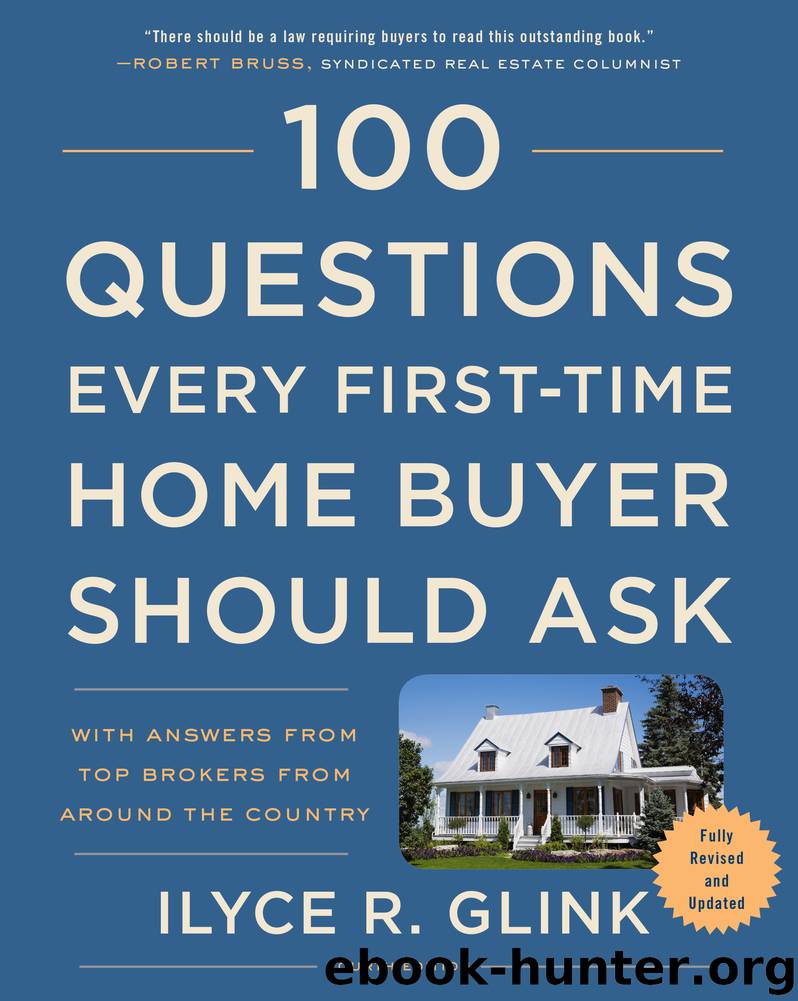100 Questions Every First-Time Home Buyer Should Ask: With Answers from Top Brokers from Around the Country (4th edition) by Ilyce R. Glink

Author:Ilyce R. Glink
Language: eng
Format: epub
Tags: Non-Fiction, Economics, Finance, Guide
Publisher: Crown/Archetype
Published: 2018-02-13T00:00:00+00:00
Question 57: How Small a Down Payment Can I Make? Where Can I Find a Zero-Down Loan?
From the 1940s through the early 1980s, if you wanted to buy a house, you had to come up with at least 20 percent in cash for the down payment. (So if you were buying a $100,000 house, you needed $20,000 in cash.) Today, if you’re buying the median-priced home in San Francisco, for example, you’d need a little more than $200,000 cash to do so.*5
In the twenty-five years I’ve been writing about real estate, study after study has shown that coming up with the down payment is one of the toughest obstacles for first-time home buyers to overcome. Scraping together that extra cash each month, on top of rent, utilities, child care, student loans, and credit card payments, excluded those whose finances were more marginal from the benefits of homeownership.
Things began to change when the FHA started permitting home buyers to purchase homes with 10 percent down, and then 5 percent down. Studies showed that defaults did increase as home buyers put less and less down on their homes, but the amount was tiny.*6 Apparently, there was a profitable market to tap. So conventional mortgages followed suit and began offering 95 percent loan-to-value ratio mortgages. Soon, FHA dropped its down payment requirement to just 3 percent. Conventional lenders followed, introducing 97 percent loan-to-value ratio loans. All of this happened before the Great Recession, and helped whip the housing market into a frenzy.
While the down payments were decreasing, lenders (led again by FHA) were increasing their debt-to-income ratios. So instead of allowing a borrower to spend only 28 percent of his or her gross monthly income on the mortgage and up to 36 percent on their total debt, home buyers were permitted to spend up to 42 percent. Industry experts saw that these marginal home buyers (made up of significant numbers of minority and immigrant families) were already spending as much as 50 to 60 percent of their gross monthly income on rent—and were making it work.
Then FHA decided home buyers only needed to put down 2 percent on a house. The rest of the down payment could be a gift from a family member, or a grant. The USDA started offering a zero-down loan for rural areas. In response, conventional lenders went a step farther. The Department of Veterans Affairs had always offered qualified veterans a true zero-down loan, but the loan was expensive. In the late 1990s, conventional lenders began offering true zero-down loans to ordinary home buyers. Some of the programs were either restricted by income or area, and some continue to be available to all home buyers.
Download
This site does not store any files on its server. We only index and link to content provided by other sites. Please contact the content providers to delete copyright contents if any and email us, we'll remove relevant links or contents immediately.
Investing For Dummies by Eric Tyson(2894)
The Book on Rental Property Investing by Turner Brandon(1779)
The Book On Tax Strategies for the Savvy Real Estate Investor by Amanda Han & Matthew MacFarland(1676)
Every Landlord's Legal Guide by Janet Portman & Stewart Marcia & Ralph Warner(1628)
The Thibaults by Roger Martin Du Gard(1571)
Personal Finance For Dummies (9th Edition) by Eric Tyson(1524)
Real Estate Licensing Exams by Raymond D. Modglin(1508)
Investing 101 by Michele Cagan(1362)
The Plaza by Julie Satow(1341)
Bill Bryson by At Home(1322)
Now I Sit Me Down by Witold Rybczynski(1291)
Irrational Exuberance by Shiller Robert J. J(1270)
The Real Book of Real Estate by Robert T. Kiyosaki(1252)
Real Estate License Exams For Dummies by Yoegel John A(1220)
7 Steps to Wealth by John L. Fitzgerald(1215)
Real Estate Math Demystified by Steven P. Mooney(1193)
Mortgages 101 by David Reed(1180)
SAP Flexible Real Estate Management by Jayant Daithankar(1170)
The Business of Flipping Homes by William Bronchick(1170)
